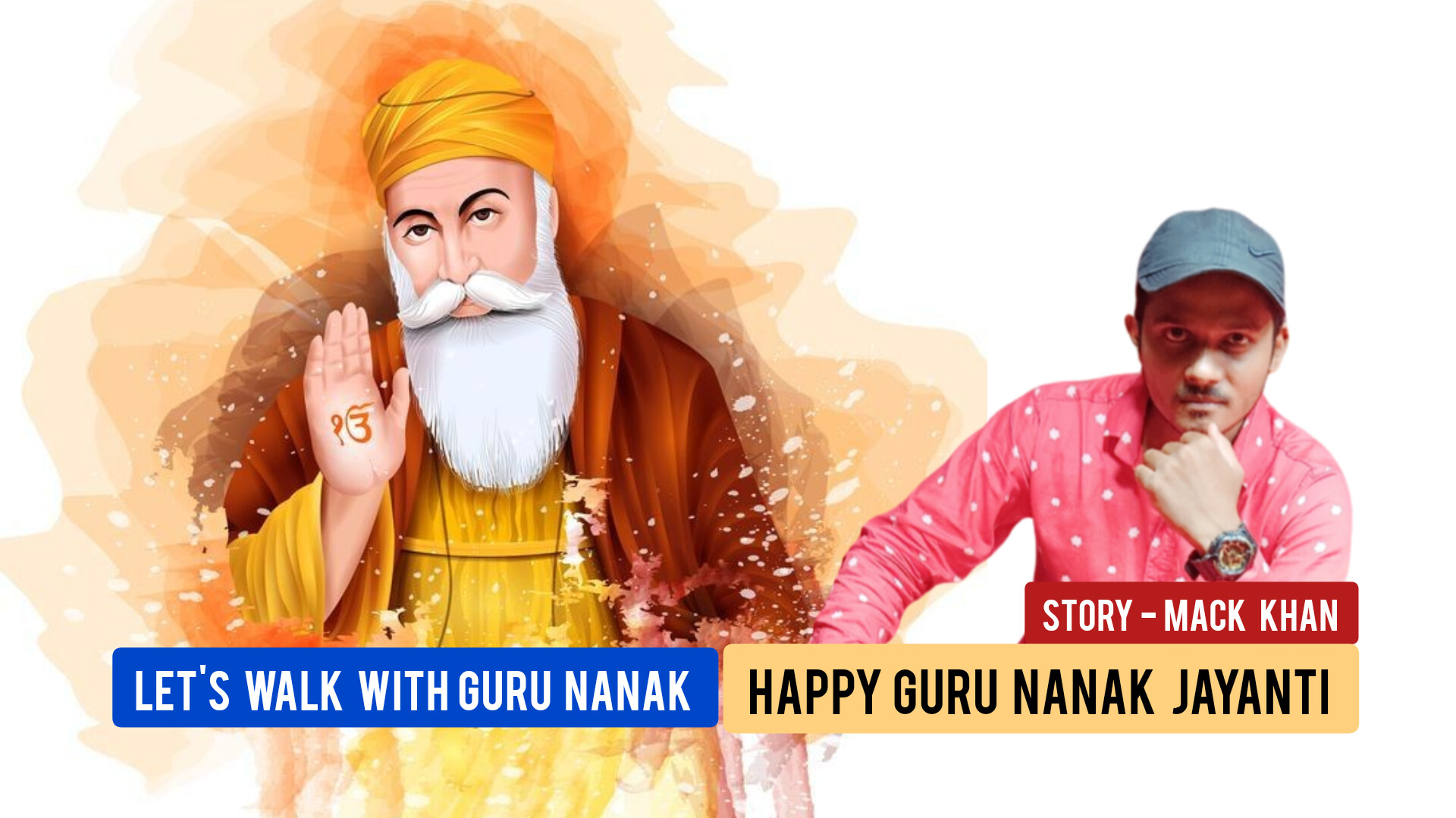
|
Getting your Trinity Audio player ready...
|
Guru Nanak, born in 1469 in Nankana Sahib (now in Pakistan), was the founder of Sikhism and the first of the ten Sikh Gurus. His birth is celebrated on Guru Nanak Jayanti. Nanak’s teachings emphasized the oneness of God, equality of all humans, and the importance of selfless service.
He spent much of his life traveling, spreading his message and engaging in dialogue with people of different faiths. His travels are collectively known as Udasis. Guru Nanak’s teachings were later compiled into the Guru Granth Sahib, the holy scripture of Sikhism.
Key principles in his teachings include Naam Japna (meditating on God’s name), Kirat Karni (earning an honest living), and Vand Chakna (sharing with others). Guru Nanak’s legacy is foundational to Sikh philosophy, and his life laid the groundwork for the Sikh community’s development.
In the Janamsakhis that record Nanak’s life story, the encounter between Nanak and Bhai Lalo is one of the most important tales. The Janamsakhis were compiled at least sixty-five years after Nanak’s death, and were collected by people who were devotees. It is believed that several miracles and stories were inserted into the Janamsakhis to give Nanak a larger than-life personality. For example, the story that mentions Nanak’s interaction with the Hindu minister, Malik Bhago, says that when Nanak appeared before him, he took a piece of bread from Bhago’s feast and when he squashed it, blood started to ooze out of it. When he did the same with Bhai Lalo’s bread, milk came out. “That’s because his food has been earned with hard work while yours has been earned by exploiting the people,’ Nanak is reported to have said.
I am not even sure if Nanak ever met with Malik Bhago. For me, the personality of Malik Bhago comes across as too tyrannical to allow Nanak to leave unharmed after he had insulted him in his haveli. Perhaps this version of the story, where Nanak and Malik Bhago meet, was an insertion from one of Nanak’s devotees. According to the legend, after Nanak’s interaction with Malik Bhago, the minister was so humbled that he not only let Nanak leave but also realised Nanak’s spiritual depth.
It is ironic to hear of stories in which miracles are associated with Nanak. Immersing myself in his philosophy, I have come to the conclusion that Nanak was repulsed by the concept of making a larger-than-life figure out of a religious leader. He spoke vehemently against miracles being associated with them. To me, he comes across as a rationalist who learnt early on in his life that most of the myths associated with saints and shrines are exactly that, myths. It is recorded that once when one of the devotees of Nanak asked him if he could perform miracles, Nanak said the following:
Dwell then in flame uninjured, Remain unharmed amid eternal ice, Make blocks of stone thy food, Spurn the solid earth before thee With thy foot, Weigh the heavens in a balance Then ask thou that Nanak perform wonders.
The beauty of Nanak’s poetry lies in his sarcasm. Babur Bani was the first poem of Nanak that I read. It is believed that Nanak wrote this poem when the first Mughal Emperor from Kabul crossed the Indus and attacked India. As a reflection of the devastation caused by the conquering army, Nanak writes:
As the Word of the Forgiving Lord comes to me, so do I express it, O Lalo. Bringing the marriage party of sin, Babar has invaded from Kabul, demanding our land as his wedding gift, O Lalo. Modesty and righteousness both have vanished, and falsehood struts around like a leader, O Lalo. The Qazis and the Brahmins have lost their roles, and Satan now conducts the marriage rites, O Lalo. The Muslim women read the Koran, and in their misery, they call upon God, O Lalo. The Hindu women of high social status, and others of lowly status as well, are put into the same category, O Lalo. The wedding songs of murder are sung, O Nanak, and blood is sprinkled instead of saffron, O Lalo. Nanak sings the Glorious Praises of the Lord and Master in the city of corpses, and voices this account.
The One who created, and attached the mortals to pleasures, sits alone, and watches this. The Lord and Master is True, and True is His justice. He issues His Commands according to His judgment. Coming in seventy-eight (1521 C.E), they will depart in ninety-seven (1540 C.E.), The body-fabric will be torn apart into shreds, and then India will remember these words, and then another disciple of man will rise up. Nanak speaks the Word of Truth:
He proclaims the Truth at this, the right time.
The Janamsakhis also record a meeting between Nanak and Babur and that too at Saidpur. It is recorded that Nanak was there to meet his friend Lalo when Mughal forces took over the city and Nanak, along with the other citizens of the city was incarcerated. In jail, he was given the task of working on a stone grinder. However, using his miraculous powers, Nanak caused the grinder to move by itself. When the prison guards saw what was happening, they immediately informed Babur who sent for the holy man.
‘Bless me, O man of God, so that I succeed in my endeavour of conquering India,’ Babur is believed to have asked Guru Nanak. ‘You have come to conquer my land and you have the audacity to ask for my blessings,’ Nanak is believed to have replied.
It comes across as rather odd that if this incident actually took place, Babur failed to mention it in his diary, Baburnama, which otherwise records meticulously every detail of his encounters. It also comes as a surprise to me that Babur allowed a man who challenged his sovereignty in court to leave without harm. That was not the way of kings then. However, in the Sikh tradition, this interaction between Nanak and Babur took on a historic meaning as it was interpreted as the beginning of the long history of hostility between the Mughal Emperors and the later Sikh Gurus.
THE GURUS OF SIKHISM
- Guru Nanak (1469-1539)
Guru Nanak, the first Guru, is believed to be the founder of Sikhism. Born at Talwandi (now known as Nankana Sahib in Pakistan) on October 20, 1469, he regarded Hindus and Muslims as equals and referred to himself as neither Hindu nor Muslim. He is believed to have made four great journeys that spanned for almost three decades. During his travels he visited many Hindu and Muslim pilgrimages including Banaras, Hardwar, Mecca and Baghdad, challenging their rituals, dogma, and the caste system. After his travels he settled at Kartarpur Sahib where he tilled land for seventeen years and preached his message through his songs and poetry. He is considered one of the greatest Punjabi poets following in the same literary tradition of Baba Farid of Pakpattan. He instituted the concept of Kirtan and Langar which became an integral part of Sikhism.
- Guru Angad (1504-1552, Guru from 1539 to 1552)
Originally called Lehna he was given the title of Guru Angad by Guru Nanak when he appointed him as his successor bypassing his progeny. Guru Angad became a disciple of Guru Nanak after he had settled at Kartarpur Sahib. After his appointment as the Guru he moved to Khadur on the instructions of Guru Nanak to avoid conflict with Sri Chand, Guru Nanak’s eldest son. Guru Angad played a crucial role in preserving Nanak’s poetry by inventing the Gurmukhi script, and committing his words in the written form. Following his Guru’s tradition he too composed verses and appointed not his son but his disciple as the next Guru.
- Guru Amar Das (1479-1574, Guru from 1552 to 1574)
After being appointed as the next Guru, Guru Amar Das was asked to move from Khadur to Goindwal by Guru Angad Dev to avoid conflict with Guru Angad Dev’s son, who wanted the seat of Gurudom for himself. Guru Amar Das played an important role in establishing the Sikhs as a distinct religious community, separate from Hindus and Muslims, by introducing various symbols, customs and institutions. He had cordial relationship with Emperor Akbar who is believed to have allotted a vast tract of land to his daughter, where later the city of Ramdaspur (Amritsar) was established. Therefore it was under him that the feudalisation of the Gurudom began.
- Guru Ram Das (1534-1581, Guru from 1574 to 1581)
Born in 1534 Guru Ram Das became the first Sodhi Guru. Following him the institution of Gurudom remained within the Sodhi family till Guru Gobind Singh. Guru Ram Das is known for starting the construction of the Harminder Sahib, which during the time of his son became the most important pilgrimage for Sikhs. Guru Ram Das is also believed to have appointed his Masand or deputies in different regions which were responsible for spreading the Guru’s message into farflung regions and also collect offerings from his devotees. This system was finally abolished by Guru Gobind Singh because of the corruption that had seeped into it. Guru Ram Das also encouraged trade which meant that the revenue of the seat of the Guru began to increase under him. Before passing away he bypassed his elder son Prithi Chand in the favour of his younger son, Arjan Dev, to be appointed as the next Guru, thus beginning a conflict that was to last for several generations after him.
- Guru Arjan Dev (1563-1606, Guru from 1581 to 1606)
Regarded as the first martryr of Sikhism, Guru Arjan was assassinated by Emperor Jahangir in the year 1606 for his alleged support to Khusro, the eldest son of Jahangir, who had rebelled against his father. The Sikhs believe that he was assassinated due to the connivance of one Chandu Shah who wanted to marry his daughter to Guru Arjan’s son, but was refused by the Guru. The assassination of Guru Arjan marks the beginning of a long conflict between Mughal authorities and Sikh Gurus. Guru Arjan is responsible for the completion of the Harminder Sahib and Amrit Sar, the pool of nectar. He also began the compilation of Guru Granth Sahib, collecting the poetry of all former Gurus and other saints of Hindu and Muslim origin which aligned with the philosophy of the Gurus. A prolific writer himself he has the greatest number of hymns in the Guru Granth Sahib followed by Guru Nanak. Guru Arjan is also responsible for introducing the daswandh, a system through which his followers were expected to contribute 10% of their earning to the cause of the Guru.
- Guru Hargobind (1595-1644, Guru from 1606 to 1644)
Known as the ‘soldier-saint’ Guru Har Gobind began the process of
militarisation of the Sikh community following the assassination of his father.
He became the first Guru to wear two swords on his person, one of which represented temporal power while the other spiritual power. He was also the first Guru to not have composed any single hymn. In the beginning of his office he remained in conflict with Emperor Jahangir, who also incarcerated him in Gwalior, but later on they established a cordial relationship with the Guru helping the Emperor in a couple of his military expeditions.
- Guru Har Rai (1630-1661, Guru from 1644 to 1661)
During the civil war between Aurangzeb and his elder brother Darah Shikoh, Guru Har Rai supported the former. It is asserted that once when Darah Shikoh fell sick and no one was able to provide him respite, he recovered through a medicine that was sent to him by Guru Har Rai. After his recovery Dara Shikoh became his devotee and their relationship continued till his death. Following in the tradition of his father he too kept a military force which he promised to Dara Shikoh against his brother. Once Dara Shikoh was captured and killed Guru Har Rai was ordered by Emperor Aurangzeb to present himself to Delhi and clarify his position during the civil war. The Guru is believed to have sent his elder son, Ram Rai, who in order to appease the Emperor misquoted a poem by Guru Nanak. The Guru disowned him hence giving birth to a new sect which was to cause trouble for the next Gurus. At his deathbed the Guru was disillusioned by the Mughal authorities and ordered his son, the next Guru, to stay away from Mughal politics.
- Guru Harkrishan (1656-1664, Guru from 1661 to 1664)
Appointed as the Guru at the age of 6, after the insolence of his elder brother Ram Rai, the child Guru found himself in a difficult situation when he was summoned to Delhi by the Emperor Aurangzeb for pretending to be the heir to his father on the complaints of Ram Rai. At his deathbed his father had ordered him to stay away from the Mughal court, however a direct order from the Emperor could also not be rejected. Travelling to Delhi with his retinue the Guru stalled his meeting with the Emperor and instead chose to serve the people of the city who were suffering from cholera and then chicken-pox. The Guru too fell sick to chicken-pox and passed away before he could appear in the Mughal court thus keeping his promise to his father.
- Guru Tegh Bahadur (1621-1675, Guru from 16644 to 1675)
Guru Tegh Bahadur was appointed as the next Guru when the Sikh community was in a precarious position. The community was divided due to the claims of various descendants of the previous Gurus. In order to take control of the situation the Guru travelled immensely forging relationships with his community and also forming new political alliances. Guru Tegh Bahadur was the second Sikh Guru to be assassinated by a Mughal Emperor. It is believed that he stood up for the right of oppressed Hindu Brahmins from Kashmir against the mighty Aurangzeb, for which he had to lose his life. Guru Tegh Bahadur was also a poet like the former Gurus and many of his hymns are included in the Guru Granth Sahib.
- Guru Gobind Singh (1666-1708, Guru from 1675 to 1708)
Before heading to Delhi Guru Tegh Bahadur appointed his son Guru Gobind Singh as his heir and the next Guru. Thus at a young age he became the head of the Sikh community. Known as a warrior and a poet the Guru worked tirelessly to protect the Sikh community from being extinguished by the Mughal Empire. He founded the Khalsa (The Pure Ones) in 1699, giving the Sikh community its distinct attire and identity. He saw the death of all of his sons during his lifetime at the hands of the Mughal authorities. He completed the composition of the Guru Granth Sahib and before his death appointed it as the next Guru for eternity.
- Guru Granth Sahib (Guru from 1708 to eternity)
Believed to be a living Guru, the Guru Granth Sahib contains the poetry of several Sikh Gurus including Guru Nanak, Guru Angad Dev, Guru Amar Das, Guru Ram Das and Guru Arjan. The Granth also contains poetry of several non-Sikh saints including Baba Farid, Bhai Mardana and Bhagat Kabir. Treated as a living Guru the Granth is provided with a special room in all Sikh Gurdwaras and is present at every Sikh ceremony.




